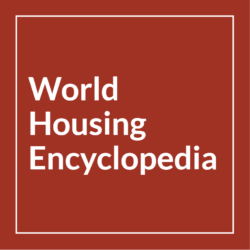The World Housing Encyclopedia (WHE ) is an Encyclopedia of Housing Construction in Seismically Active Areas of the World, hosted by the Earthquake Engineering Research Institute (EERI) and the International Association for Earthquake Engineering (IAEE).
Our Goals
- To share knowledge on housing construction practices
- To encourage use of earthquake-resistant technologies
- To develop guidelines and technical resources for improving seismically vulnerable construction
- To offer services and technical support to communities across the world on earthquake resistant housing technologies
Purpose
The WHE compiles and shares information on housing construction practices from earthquake-prone areas around the world. The target audience includes engineers, architects, builders, risk managers, and housing experts. To date, more than 180 prominent engineers and architects from 47 countries have been associated with the project, primarily as volunteers working through e-mail and uploading information onto this website. This website presents the most complete and global collection of information about housing construction practices in diverse parts of the world. It is a living resource that continues to grow as expert knowledge advances and it is available anywhere in the world free of charge.
Background
The WHE project was inaugurated in January 2000 at the 12th World Conference on Earthquake Engineering in Auckland, New Zealand. Since that meeting, volunteer participants have designed the website, contributed information, and promoted the use of the site with colleagues. For some construction types, this is one of the few, if not only, places where such detailed information is available in English.
Next Steps
The performance of housing in earthquakes is one element in a larger picture of sustainable development practices that includes the relationship between housing, poverty, and the natural environment. Millions of people live in unsafe housing around the world, depriving them of a basic human right. Such housing is unsafe for many reasons, including poor location, poor construction materials, and poor maintenance. Communities that fail to take into account seismically resistant siting, design, and construction lose lives in earthquake after earthquake and must spend limited resources rebuilding over and over again. This cycle draws limited resources away from other needed development projects and economic growth.
Today, experts know a lot about how to build and strengthen homes to resist earthquake shaking, including homes built out of mud, stone, and other traditional materials not commonly used in engineered structures. Nonetheless, most homes built in developing countries with earthquake hazards do not utilize this knowledge. Even immediately after an earthquake, many homes are rebuilt in the exact same unsafe way they existed prior to their collapse. There are many reasons for this, including lack of knowledge about affordable structural solutions. limited availability of engineering and construction expertise, and poor oversight and enforcement of laws regulating construction. Often, a root cause of unsafe housing is poverty; many of the world’s poor have no choice but to live on the cheapest lands and in unsafe construction. However, often homes in earthquake zones can be built more safely for a marginal increase in cost. There is a great need for accessible, trustworthy, up-to-date information about earthquake-resistant housing design, construction, and policy. Over time, through the dedication of a global network of committed volunteers, the World Housing Encyclopedia will grow into such a resource.
About EERI
The Earthquake Engineering Research Institute (EERI) is a national, nonprofit, technical society of engineers, geoscientists, architects, planners, public officials, and social scientists. EERI members include researchers, practicing professionals, educators, government officials, and building code regulators. The objective of EERI is to reduce earthquake risk by advancing the science and practice of earthquake engineering; improving understanding of the impact of earthquakes on the physical, social, economic, political, and cultural environment; and advocating comprehensive and realistic measures for reducing the harmful effects of earthquakes.
EERI is a leader in earthquake investigations and in the dissemination of earthquake risk reduction information both in the US and globally in cooperation with its international partners.
The latest news on EERI can be found at The Pulse of Earthquake Engineering, the bi-weekly email newsletter of the Earthquake Engineering Research Institute.
About IAEE
The International Association for Earthquake Engineering (IAEE) is a non-profit organization that includes representation from the world’s national earthquake engineering societies, each national society having a Delegate to the IAEE. The IAEE is responsible for selecting the venue and local organizing society for each of the World Conferences on Earthquake Engineering. It compiles and updates Regulations for Seismic Design: A World List, as well as other issue publications as necessary.
Its flagship periodical, the journal titled Earthquake Engineering and Structural Dynamics, has been a leading publication in the field since 1972. The IAEE’s fundamental goal is to help improve worldwide seismic safety.
